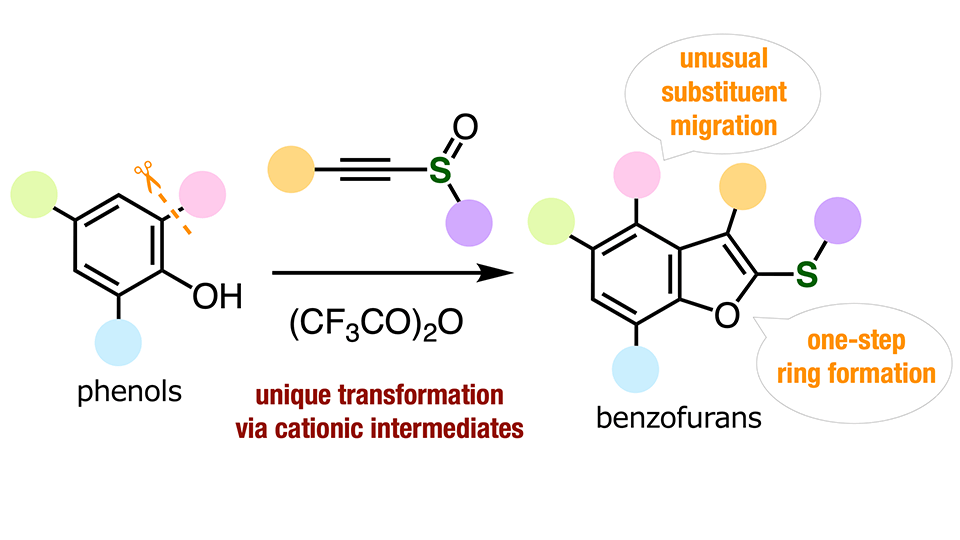A team led by Associate Professor Suguru Yoshida from Tokyo University of Science has developed a new method for synthesizing complex molecules, specifically benzofurans, through a process called substituent migration. This technique involves rearranging functional groups within a molecule. The team’s findings, published in Chemical Communications, could have significant implications for the pharmaceutical and agrochemical industries, potentially leading to better anti-cancer drugs, antibiotics, fungicides, and herbicides. The method could also be used in biological research, textile dyes and pigments, fragrances, and organic-electronic or fluorescent materials.
Benzofuran Synthesis: A Novel Approach to Complex Molecule Creation
In the realm of organic chemistry, the discovery of new reaction types often paves the way for the synthesis of complex compounds. This is particularly true in the pharmaceutical and agrochemical industries, where advancements are often linked to the discovery of novel, practical reaction pathways. These pathways typically involve the selective replacement of one functional group with another, the formation of aromatic rings, or the strategic cleaving of parts of a molecule. However, a team of researchers from Tokyo University of Science (TUS), Japan, has recently explored a different approach: the rearrangement of existing functional groups within a molecule.
This process, known as ‘substituent migration,’ involves getting a functional group on an aromatic ring to move to a different position within the ring. While chemists have developed several strategies for functional group migration, the process becomes significantly more challenging when dealing with arenes with a high number of functional groups. The team, led by Associate Professor Suguru Yoshida, has recently published a paper in Chemical Communications detailing a new technique to synthesize various benzofurans through precise molecular rearrangement and substituent migration.
Unusual Substituent Migration: A Surprising Discovery
The researchers were surprised to discover an unusual substituent migration when treating a simple aromatic compound known as o-cresol with alkynyl sulfoxide (AS) and trifluoroacetic anhydride (TFAA). This reaction partially yielded a compound in which the functional group that would typically be next to the -OH group position was instead at the neighboring position of the aromatic ring through benzofuran ring formation. This unexpected result prompted further investigation into AS/TFAA-mediated reactions.
The team found that when a substituted phenol reacts with AS and TFFA, TFAA first activates AS, leading to the formation of a five-membered ring sharing one of its sides with the phenol. This resulting molecule is a benzofuran. The imbalanced charges on the benzofuran then trigger a ‘charge-accelerated sigmatropic rearrangement,’ allowing the ortho functional group to migrate to the neighboring position on the phenol side.
Versatility and Potential Applications of the New Synthesis Strategy
The researchers demonstrated the versatility of their strategy by synthesizing a wide variety of benzofurans, some of which were highly functionalized or even fully functionalized. The yields of some of these compounds were exceptionally good, and the composition of the functional groups was not damaged or altered by the process. “Our modular synthesis method enabled us to produce diverse highly substituted benzofurans from easily available starting materials through substituent migration,” highlights Dr. Yoshida.
Benzofurans have already been used as important bioactive compounds, and the newly accessible benzofurans could be of great importance in pharmaceutical sciences and agrochemistry. Beyond these fields, the potential applications of new highly functionalized benzofurans extend to biological research, textile dyes and pigments, fragrances, and even organic-electronic or fluorescent materials.
Future Directions: Perfecting the Synthesis Technique and Exploring Further Applications
The researchers are now focused on perfecting this promising synthesis technique and exploring more ways to control substituent migration. “Applications to the development of bioactive benzofurans, the synthesis of various heteroaromatics through similar reaction mechanisms, and theoretical studies with density functional theory calculations are ongoing in our laboratory,” says Dr. Yoshida.
This study has unlocked an innovative way of synthesizing complex benzofurans, potentially paving the way to better anti-cancer drugs, antibiotics, fungicides, herbicides, and more. The researchers’ efforts could have far-reaching implications, not only in pharmaceutics and agrochemistry but also in a wide range of other fields.
About Tokyo University of Science
Tokyo University of Science (TUS) is a respected university and the largest science-specialized private research university in Japan, with four campuses in central Tokyo and its suburbs and in Hokkaido. Established in 1881, the university has continually contributed to Japan’s development in science. TUS has embraced a multidisciplinary approach to research and undertaken intensive study in some of today’s most vital fields. It is the only private university in Japan that has produced a Nobel Prize winner and the only private university in Asia to produce Nobel Prize winners within the natural sciences field.
External Link: Click Here For More

